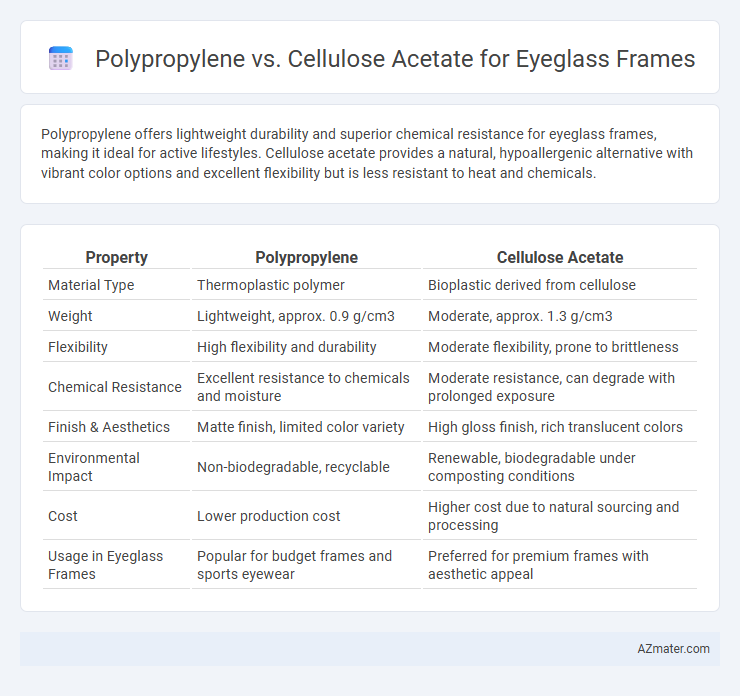Polypropylene offers lightweight durability and superior chemical resistance for eyeglass frames, making it ideal for active lifestyles. Cellulose acetate provides a natural, hypoallergenic alternative with vibrant color options and excellent flexibility but is less resistant to heat and chemicals.
Table of Comparison
| Property | Polypropylene | Cellulose Acetate |
|---|---|---|
| Material Type | Thermoplastic polymer | Bioplastic derived from cellulose |
| Weight | Lightweight, approx. 0.9 g/cm3 | Moderate, approx. 1.3 g/cm3 |
| Flexibility | High flexibility and durability | Moderate flexibility, prone to brittleness |
| Chemical Resistance | Excellent resistance to chemicals and moisture | Moderate resistance, can degrade with prolonged exposure |
| Finish & Aesthetics | Matte finish, limited color variety | High gloss finish, rich translucent colors |
| Environmental Impact | Non-biodegradable, recyclable | Renewable, biodegradable under composting conditions |
| Cost | Lower production cost | Higher cost due to natural sourcing and processing |
| Usage in Eyeglass Frames | Popular for budget frames and sports eyewear | Preferred for premium frames with aesthetic appeal |
Introduction to Eyeglass Frame Materials
Polypropylene offers lightweight, flexible, and durable properties ideal for eyeglass frames, with excellent chemical resistance and affordability making it popular in mass production. Cellulose acetate, derived from natural cotton fibers, provides a more premium feel with superior color range, hypoallergenic properties, and enhanced aesthetic appeal due to its ability to be easily molded and polished. Choosing between polypropylene and cellulose acetate depends on priorities like comfort, design versatility, and budget constraints in eyewear manufacturing.
Overview of Polypropylene in Eyewear
Polypropylene is a lightweight, durable thermoplastic polymer widely used in eyeglass frames due to its excellent chemical resistance and flexibility, which enhances wearer comfort and frame longevity. Its low density and resistance to stress cracking make it an ideal material for frames subjected to daily wear and tear, while its cost-effectiveness supports affordable eyewear production. Polypropylene's ability to be easily molded into various shapes and colors also contributes to diverse and customizable frame designs in the optical industry.
What is Cellulose Acetate?
Cellulose acetate is a plant-based thermoplastic derived from cellulose fibers, commonly used in eyeglass frames for its lightweight, hypoallergenic properties and excellent color retention. Unlike polypropylene, which is a synthetic polymer known for flexibility and toughness, cellulose acetate offers a high-gloss finish and the ability to achieve intricate patterns and rich hues. Its natural origin and biocompatibility make it a preferred choice for consumers seeking eco-friendly and stylish eyewear options.
Material Properties: Polypropylene vs Cellulose Acetate
Polypropylene offers superior impact resistance and flexibility, making eyeglass frames lightweight and durable, while its chemical resistance ensures longevity. Cellulose acetate provides excellent aesthetic appeal with a glossy finish and vibrant color options, but it is less flexible and can be prone to warping under heat. Both materials are hypoallergenic; however, polypropylene frames excel in moisture resistance compared to cellulose acetate, which can absorb sweat and oils over time.
Durability and Flexibility Comparison
Polypropylene eyeglass frames offer superior flexibility and impact resistance due to their thermoplastic properties, making them less prone to breakage under stress. Cellulose acetate frames, while more rigid and stylish with a textured finish, tend to be less durable and can become brittle over time, especially with exposure to heat and moisture. Polypropylene's resilience and lightweight nature enhance comfort and longevity, whereas cellulose acetate's appeal lies more in aesthetic versatility than mechanical endurance.
Weight and Comfort Analysis
Polypropylene eyeglass frames are significantly lighter than cellulose acetate frames, contributing to enhanced comfort during extended wear. The low density and flexibility of polypropylene reduce pressure on the nose and ears, minimizing fatigue and irritation. In contrast, cellulose acetate offers higher rigidity and weight, which may cause discomfort despite its aesthetic appeal.
Style, Color, and Design Options
Polypropylene eyeglass frames offer a wide range of vibrant colors and modern, flexible design options, making them ideal for bold, contemporary styles. Cellulose acetate frames provide rich, natural hues and intricate patterns, favored for classic, high-end designs with a polished finish. Both materials allow diverse customization, but polypropylene excels in lightweight, durable frames while cellulose acetate stands out in luxurious texture and color depth.
Environmental Impact and Sustainability
Polypropylene frames are highly recyclable and generated from petroleum-based polymers, leading to lower biodegradability and potential microplastic pollution. Cellulose acetate is derived from natural cotton fibers combined with wood pulp, making it biodegradable and more environmentally sustainable, despite higher resource use during production. Choosing cellulose acetate supports eco-friendly eyewear due to its renewable origin and compostability compared to synthetic polypropylene's longer degradation timeline.
Cost and Affordability Factors
Polypropylene eyeglass frames offer superior cost efficiency due to their low production expenses and lightweight properties, making them highly affordable for mass-market consumers. Cellulose acetate frames, while slightly more expensive, provide enhanced aesthetic appeal and durability but involve higher manufacturing costs, influencing retail prices. Consumers seeking budget-friendly eyewear typically favor polypropylene for its balance of affordability and functional performance.
Choosing the Right Material for Your Eyeglass Frames
Polypropylene offers lightweight durability and excellent chemical resistance, making it an ideal choice for eyeglass frames that require flexibility and long-lasting wear. Cellulose acetate stands out for its natural look, hypoallergenic properties, and wide range of color options, providing stylish comfort for sensitive skin. Selecting between polypropylene and cellulose acetate depends on prioritizing either lightweight resilience or aesthetic appeal combined with skin-friendliness in your eyeglass frames.

Infographic: Polypropylene vs Cellulose acetate for Eyeglass frame
 azmater.com
azmater.com